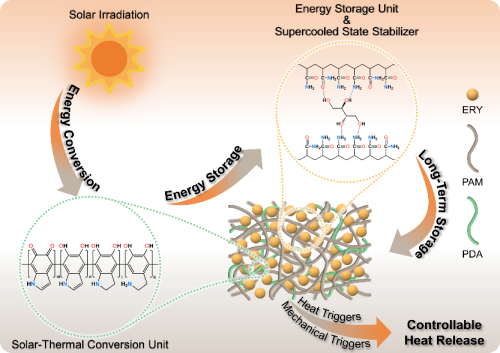Solar thermal fuels, or STFs, can transform solar energy into chemical energy that can be stored for a long period and released as thermal energy when required, utilizing certain triggers.
 Schematic diagram of the composite STPCM. Image Credit: ZHANG Shihui
Schematic diagram of the composite STPCM. Image Credit: ZHANG Shihui
STFs show promise for solar thermal applications since they can overcome the issues of intermittent solar energy supply and weather/geographic reliance. However, current work on STFs is mostly focused on molecule-based materials with distinct molecular conformations that exhibit energy disparities, posing issues in practical large-scale applications.
A research group led by Prof. SHI Quan from the Dalian Institute of Chemical Physics (DICP) of the Chinese Academy of Sciences (CAS) recently presented an erythritol (ERY)-based spatiotemporal phase change material (STPCMs) that can act as a new type of STF with the potential for large-scale applications.
Angewandte Chemie International Edition published the study on February 20th, 2024.
The researchers demonstrated that the created erythritol-polyacrylamide-polydopamine (ERY-PAM-PDA) composite STPCMs were capable of spatiotemporal thermal energy consumption and photothermal conversion.
They also found that after introducing a photothermal conversion unit, the composite STPCM demonstrated high photothermal conversion efficiency, allowing for the conversion and storage of solar energy into thermal energy.
Furthermore, the composite STPCM could store thermal energy at room temperature for more than a month before releasing it under controlled conditions via thermal induction or mechanical triggering. The cold crystallization enthalpy can reach 224.9 J/g, and the released latent heat could heat the system from 25 °C to 91 °C.
The composite STPCM described in this study offers a viable alternative to molecular-based STFs. It demonstrated spatiotemporal usage of thermal energy as well as photothermal conversion in the visible light range. Furthermore, it possessed easy preparation procedures, employed inexpensive and widely accessible raw ingredients, and was suitable for large-scale production.
This work provides a new direction for the application of STPCMs and the development of solar thermal utilization technology.
Quan Shi, Professor, Dalian Institute of Chemical Physics, Chinese Academy of Sciences
The National Key Research and Development Program of China and the National Nature Science Foundation of China provided funding for the study.
Journal Reference:
Chen, J., et. al. (2024) Spatiotemporal Utilization of Latent Heat in Erythritol-based Phase Change Materials as Solar Thermal Fuels. Angewandte Chemie International Edition. doi:10.1002/anie.202400759